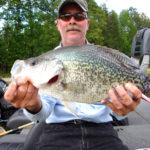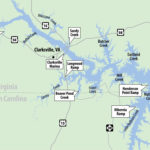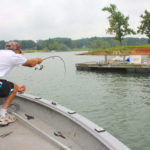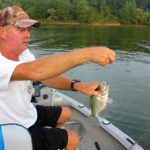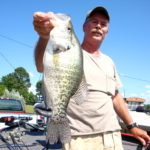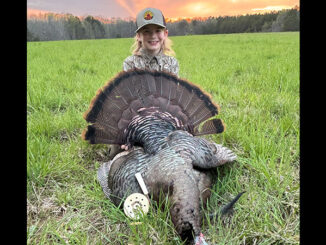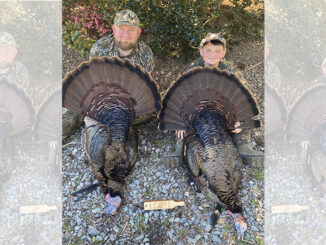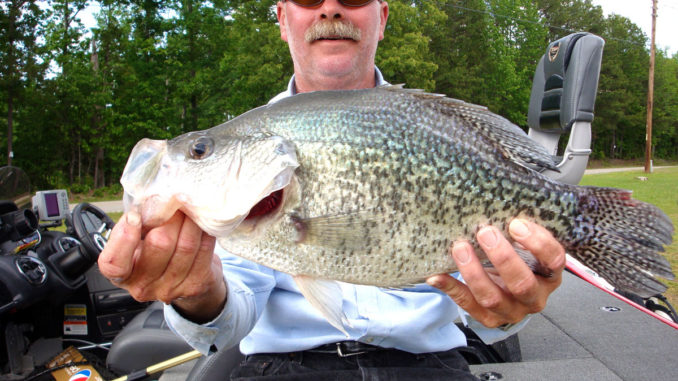
Boat docks and brush piles will hold a lot of postspawn crappie at Kerr Lake this month.
May is largely a transition month for crappie across North Carolina, and Kerr Lake, aka Buggs Island, is no different. Nearly all crappie have completed the spawn on the 49,500-acre reservoir that straddles the North Carolina-Virginia border are in some stage of moving from their shallow spawning grounds back to deeper water.
Fortunate for fishermen, crappie are likely to gang up around structure after leaving the spawning flats and turn their attention from reproduction to eating.
Boat docks are a magnet for underwater life, and from the backs of creeks near spawning areas to the main lake they provide prime habitat for fish in the early stages of postspawn. Crappie use docks as a place to recover from the rigors of spawning and feast on the baitfish they draw. As the water temperature rises, crappie will be driven from the shallowest docks to the deepest in search of comfortable water, and eventually away from the docks onto brush and rock piles.
Guide Chris Bullock of Fountain said May is the best month to catch crappie around boat docks. Bullock, who runs Kerr Lake Crappie and Cats Guide Service, starts by investigating docks in the back of creeks adjacent to areas where he’s recently caught spawning fish, sometimes finding them under the planks in late April.
“If we have low water during the spawn, the shallowest docks will only be in a few feet of water, and they may have crappie spawning under them. But most docks will be in 6 to 8 feet of water,” he said. “I follow the activity from the shallows to the mouths of the creeks and out to the main lake as the water temperature increases.”
Due to the fluctuation in water level, it is illegal to build a boat dock that is affixed to the lake floor at Kerr Lake, which was impounded in 1952 for flood control and to produce hydroelectric power. In addition to a substantial flood pool level, Kerr is also drawn down during the winter.
While not having pilings lessens the amount of hard structure a dock might provide, floating docks are always close to the water’s surface, providing excellent cover. The floats fill in gaps between the boards, providing more shade, and without pilings, there aren’t any obstructions to cost you jigs or hooked fish.
Getting a jig back under a floating dock to a crappie’s strike zone requires a specialized technique known as “shooting.” To thread the needle, Bullock holds the jighead between his thumb and forefinger and holds the line coming off his spool with the forefinger of his other hand. He crouches on the bow, bends the rod double and releases the jig and line in rapid succession; skipping the jig 25 to 40 feet under the dock.
“Docks with the smallest space between the floats provide the most cover and the most crappie,” Bullock said. “Let the jig fall and count until you feel a ‘tick’ or see the line move. Most crappie will hold near the same depth. On the next cast, count down and start retrieving slowly at that depth.”
Bullock prefers a 1/16-ounce jighead with a Bobby Garland Baby Shad body, 6-pound monofilament, and a 6-foot light action spinning rod for dock shooting.
Another Kerr Lake guide, Keith Wray of Fish Doc Guide Service in Eden, spends most of every May pounding crappie. He considers the creeks north of Clarksville to be the best spawning creeks due to their relative shallowness compared to those on the lower end of the lake, so those docks should be the first to hold crappie recuperating from the spawn.
“The progression of the bite starts with Peters, Aarons, Buffalo, Sandy, Bluestone and Orange creeks; that’s where they spawn the heaviest,” said Wray, said the extreme back ends of Grassy, Butcher and Nutbush creeks are also shallow and prime for spawning.
“I’ll shoot docks in the creeks until the water reaches about 75 degrees,” said Wray. “By mid- to late May,fish should be out on the main-lake docks in 10 to 12 feet of water.”
Although docks may be the easiest form of structure to find, learning which ones hold fish and which ones are barren is what separates good fishermen from pretenders.
“When you look down a row of docks, pick out the one or two that’s sticking out the farthest. They are most likely the closest to the channel and the most productive,” said Bullock, who also likes to mix docks with brush. “Ninety percent of the docks on Kerr don’t have any cover, but those that do outshine the rest. Most of that cover will be Christmas trees or brush piles that someone has set out.”
Bullock said that side-imaging sonar is invaluable for finding additional cover placed close to a dock and even crappie if they are in a large school.
According to Wray, larger docks are best, and the presence of pontoon boats is the icing on the cake.
“Last May, we found a dock in a small cove off the main channel with three pontoons, one under the shelter, and one on each side,” he said. “We caught 100 crappie in one setting and left them biting.”
Although effective, there is a bit of an art to dock shooting, and the novice should consider a little practice to sharpen his skills before going live.
“We used to make a game of it,” said Bullock. “We’d line up some chairs in the yard and set a 5-gallon bucket on its side at the end. We’d start at 25 feet go up to 40 feet, and see who could hit the bucket the most consecutive times. When you think you’re good, you can start using a coffee can.”
Water temperature is the biggest factor that affects the movement of crappie, and it can range wildly from year to year. A hot May is likely to move fish away from the docks and onto brush and rock piles, especially toward the end of the month. If that’s the case, Bullock has his GPS unit loaded with over 2,000 waypoints marking brush piles that he has made and found.
“I’ve got enough brush marked to handle whatever water depth the fish are using,” said Bullock, noting that the height of the brush pile is just as important as the depth of water it’s in. “A brush pile in 15 feet of water may reach to 7 or 8 feet from the surface, and that’s usually where the crappie will be. We place them on slopes, in channel bends in the creeks, and out to points main lake.”
Bullock approaches a brush pile by first marking it on his sonar, and then lobbing a marker buoy to one side in order to locate it visually. Backing off to a good casting distance, he fires in a 1/16-ounce jig with a soft-plastic shad or curlytail body.
“Count it down to the top of the brush and make a slow and steady retrieve. The jig should fall at about a foot per second,” he said. “If the bite is tough, you may have to bump the cover to get bit.
“The best days to fish brush piles are bright and sunny. That makes them hold close to the brush to get out of the bright light. They will usually spread out more on cloudy days.”
Wray also fishes bush in late May, but he will also add rock piles to his repertoire.
“Most of the rocks I fish are off main-lake points rising 8 to 10 feet from the surface,” he said. Rock piles are both natural formations as well as areas exposed during the construction of the lake.
“I learned to fish where the points have a natural eddy effect, either from the river’s flow or when they’re pulling water to make power,” said Wray. “It’s just like fishing a small stream; the eddy collects zooplankton, which attracts baitfish. The fish that feed on the baitfish know this, and they set up downcurrent to feed.”
Wray fishes a 3/32-ounce jighead with a soft-plastic shad body, curlytail or tube; he usually has one of each tied on different rods. He usually starts with white or another bright color and gradually works down to darker colors to find a bite or keep a hot bite going.
DESTINATION INFORMATION
HOW TO GET THERE — Kerr Lake lies along the North Carolina-Virginia border, roughly between South Boston, Va., and Henderson, N.C. Best access is by US 58, US 15 and I-85. On the upper end of the lake, the Longwood Ramp off US 15 near Clarksville, Va., offers good access, as does Clarksville Marina, between US 15 and US 158. On the lower end, Henderson Point off NC 39 north of Townsville and two ramps in Nutbush Creek — Hibernia off NC 39 and Satterwhite Point off I-85 are popular ramps.
WHEN TO GO — To target crappie around boat docks, plan trips for the last week or two of April through May. Brush piles and rock piles also come into play in May when fish move from docks to deeper structure.
BEST TECHNIQUES — “Shooting” docks is all about artificial baits. Anglers can slingshot 1/16-ounce jigheads with soft-plastic shad bodies or curlytails in bright colors like white and chartreuse. Skip the jigs as far back under docks as possible. When fish move to brush piles or rock piles, a 1/16- or 3/32-ounce jig should be cast and counted down until it’s just above the bottom.
FISHING INFO/GUIDES — Chris Bullock, Kerr Lake Crappie and Cats Guide Service, 252-902-4039, www.kerrcrappieandcats.com; Keith Wray, Fish Doc Guide Service, 336-589-9025. See also Guides and Charters in Classifieds.
ACCOMMODATIONS — Lake Motel, Clarksville, Va., 434-374-5500; Hampton Inn, Henderson, 252-492-3007; Vance County Tourism Department, 866-438-4565; www.kerrlake-nc.com/kerrlake.cfm#.VRA5j_nF_X4
MAPS — GMCO Maps, 888-420-6277, www.gmcomaps.com; Fishing Hot Spots, 800-ALL-MAPS, www.fishinghotspots.com.

